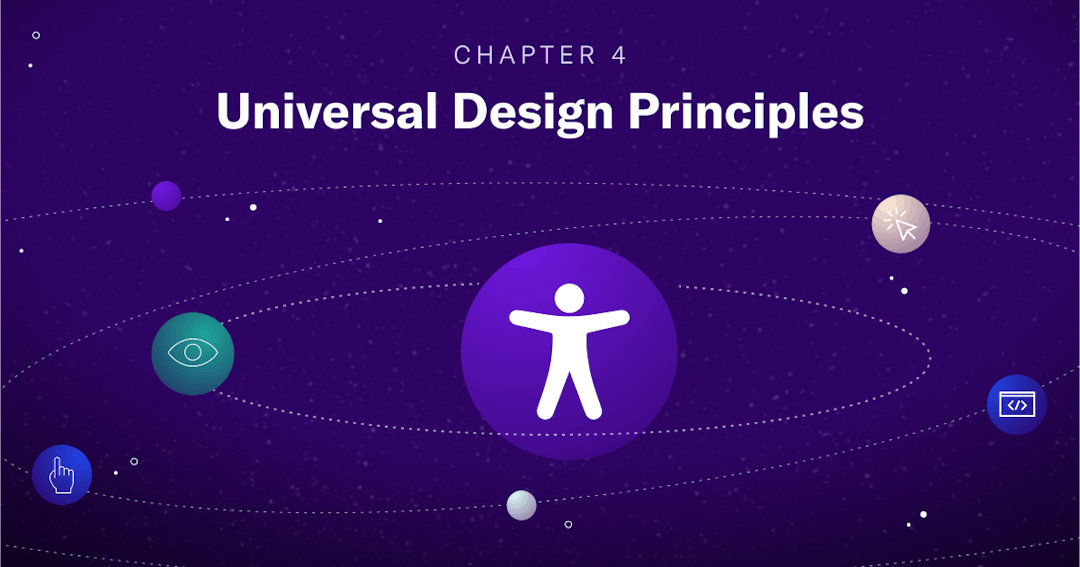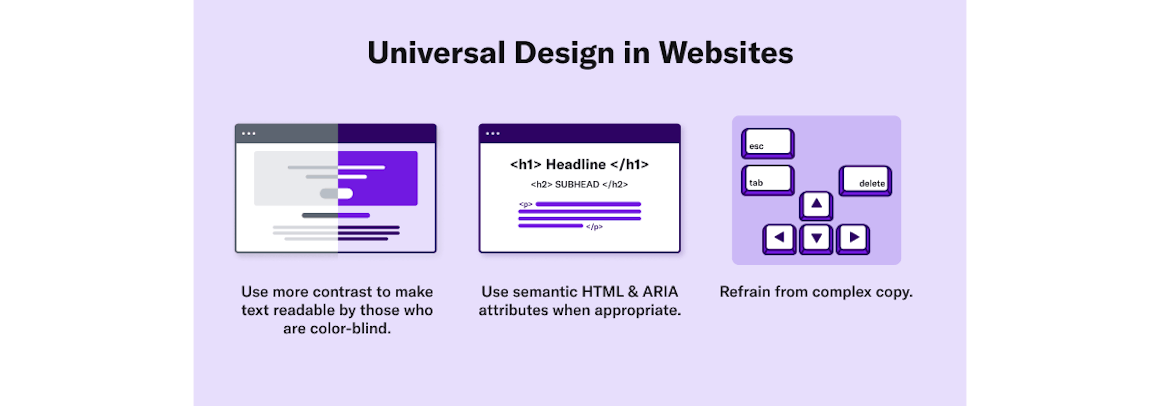CHAPTER 4
Seven Universal Design Principles
A Comprehensive Guide on Accessible Web Design

Explore The Guide
In the digital economy, where people switch brands at the drop of a hat, providing customer-centric user experiences is key to attracting and keeping loyal customers. And that means making every interaction with your brand easy and useful, creating user experiences that meet people at the point of their needs. In this article, we cover universal design principles that can help you make your website accessible to all users, regardless of ability.
What is Universal Design?
Universal design is sometimes used interchangeably with accessible design, even though the two processes differ from each other. Accessible design is concerned with the needs of individuals with disabilities, while universal design — as its name suggests — aims to serve everyone. The key takeaway here is that, if you use universal design principles, you’ll make your website more accessible to all people, including individuals with disabilities.
Now, let’s dive into seven universal design principles, which govern both physical and digital realms.
1. Equitable Use
Provide the same means for all users. For example, make sure your website is accessible to people who use screen readers to consume and interact with content online.
2. Flexibility in Use
Offer options that accommodate individual user preferences, such as right- and left-handed UI.
3. Simple and Intuitive Use
Make your product and/or website easy to understand and navigate for any user. Don’t make any assumptions about users’ knowledge or prior experience.
4. Perceptible Information
Communicate necessary information to the end user in a clear and accessible way. If you are posting a video, make sure it has closed captioning and audio descriptions, along with images, so it’s accessible to people who are deaf or have hearing impairments.
5. Tolerance for Error
Provide guidance to prevent users from making an error or taking an unintended action. Remember to add fail-safe features in key elements. Session timeout reminders are an example of providing tolerance for error.
6. Low Physical Effort
Design physical or digital spaces for comfortable use. Enable keyboard shortcuts to allow users to complete online tasks with minimal keystrokes.
7. Size and Space for Approach and Use
Provide appropriate size and space for approach, reach, manipulation, and use, regardless of users’ body size, posture, or mobility. Examples include adjustable desks in the physical world and responsive web design for viewing content on mobile devices.
Remember to consider universal design throughout your entire design process, and, most importantly, at the beginning of a project.

Universal Design in Websites
Now let’s look at a few ways you can apply universal design principles when designing or updating your website.
- Use strong color contrast to make text readable for people with color blindness. Read 8 Ways to Design a Color Blind Friendly Website to get more tips.
- Use semantic HyperText Markup Language (HTML) and Accessible Rich Internet Application (ARIA) attributes when appropriate.
- Provide closed captioning and video descriptions to make your content accessible to people who are deaf or have hearing impairments.
- Add text descriptions, or ALT text, to your images. Find more information in our post on Image Alt Text.
- Create user-friendly website content with proper page formatting, headings, and typography. To learn more, read How to Build User-Friendly Web Page Content.
- Make sure your site is navigable by people who use the keyboard alone. See what that looks like in our post on Keyboard Focus and Dialog Behavior.
Universal Design and Accessibility
Whether you’re just starting on a new website or exploring a design refresh, we hope you’ll apply the universal design principles and use our quick tips to make your website accessible. By making your website accessible to people of all abilities, you will be able to reach wider audiences and better serve all your customers.
Not sure where to begin? AudioEye is here to help. Our team of Certified Professionals in Accessibility Core Competencies (CPACC) can guide you on every step of your accessibility journey.
Chapter 5: Link Accessibility
Read Other Chapters
See all chapters from the Comprehensive Guide on Accessible Web Design.